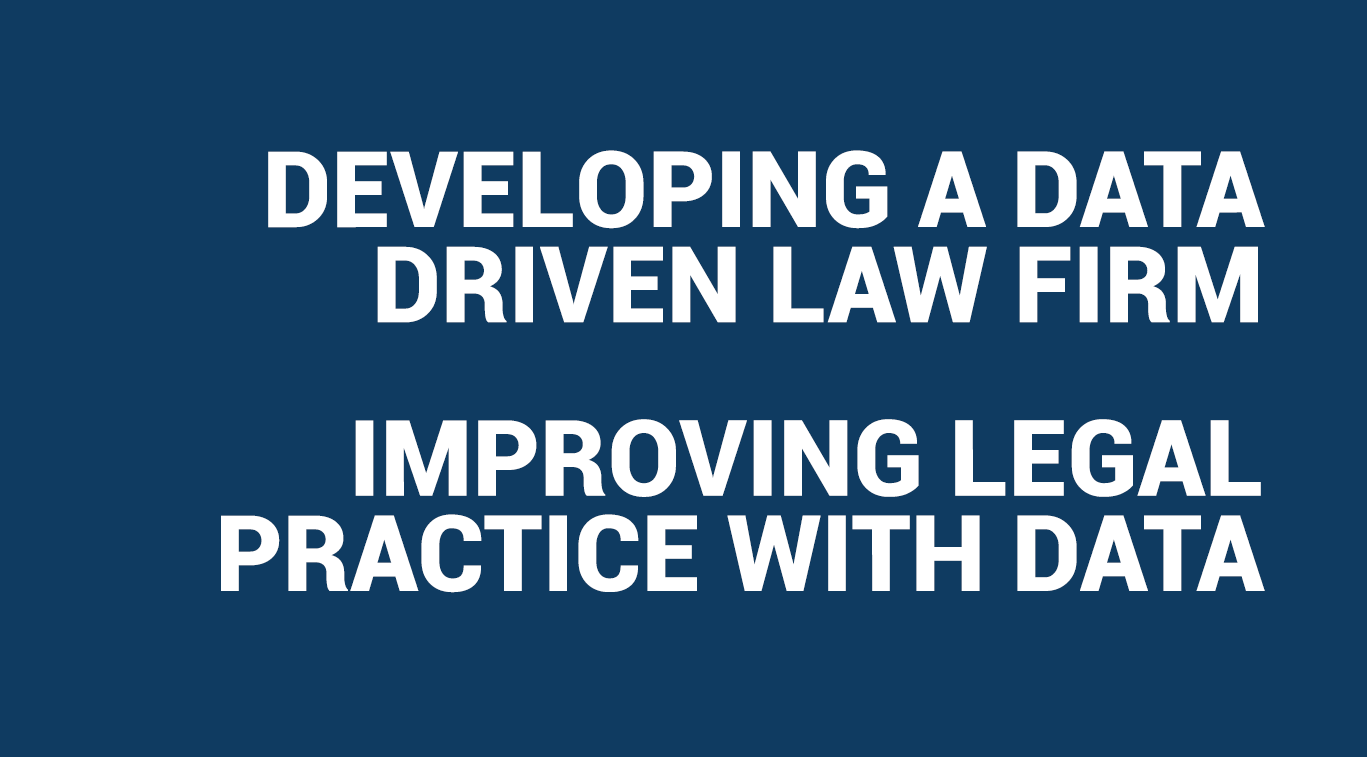Developing A Data Driven Law Firm: Improving Legal Practice With Data

Written by Maryam Khan
Blogger

The legal industry and the world of data analytics may have been seen as a traditionally ‘odd’ combination. However, the integration of both has become a crucial component for a law firm’s success, growth and profitability. Law firms and corporate legal departments are transitioning to a more ‘data-driven’ approach to how their business is carried out. The insights and patterns generated through data analytics for lawyers within a firm both through internal and external data can significantly improve its performance, productivity levels and overall competitiveness in the legal sector [1].
What Does It Mean To Be Data-Driven?
Law firms already deal with considerable information and heavily depend on sharing and processing information. Be it contracts, invoices, written communications, case bundles or client profiles; lawyers deal with significant amounts of data on a daily basis. However, law firms are now prioritising shifting to digital technologies that better manage this data flow to make the most of it.
A data-driven law firm values the relationship between effective data analysis and successful legal practice. Such law firms are eager to leverage data to track performance, identify problems, and map out future business growth plans [2]. Adopting a data-driven approach means regularly assessing inefficiencies within law firms and identifying opportunities to grow using the collected internal data. This data compares yearly revenue to discover inconsistencies or identify which practice area is the most profitable [3]. Harnessing external data also allows law firms to analyse client behaviour better to adopt more strategic business and marketing strategies. An example of such external data is the information of potential clients who constantly visit the firm’s website and the firm’s social media audience [4].
Regular analysis of such information is a product of adopting a data-driven approach that allows you to understand the strengths and weaknesses of your practice, and by having access to such data, law firms can better plan for the future and drive business growth by fostering data-driven decision making.
The 6 Steps To Start Your Data-Driven Journey
Establishing a data-driven law firm is less about having the most high-tech and advanced legal data analytics tools and is more about having a structured process to measure business goals and process the right data.
Step 1: Set Business Goals & Objectives
If you want to use data analytics to grow your law firm’s practice, you first need to identify the goals you are planning to achieve. Defining your business goals and having a structured plan for the future is a crucial first step. For example, if you have set a goal to increase productivity levels by 25% this financial year, you can now move on to decide which data needs to be collected and how it will be analysed. This structured analysis will help you understand your business better and achieve your goals [5]. If a clear cut goal is not identified, it becomes more difficult to understand what data needs to be analysed. Failing to prioritise business goals will clear confusion regarding what to do with the data and how to leverage it to promote business growth.
Step 2: Identify Key Performance Indicators (KPIs)
The second step is to define the factors and insights you wish to consider when measuring your success levels. These insights are referred to as ‘Key Performance Indicators (KPIs)’. When outlining KPIs, it is important to ensure that they can be regularly measured to shed light on their progress. Examples of key performance indicators include the total cost of services, legal spend as a percentage of revenue, cost per matter, deadline compliance and legal matters handled versus revenue [6]. After law firm KPIs are defined, they can be reviewed regularly to track what factors are driving productivity and profitability. Areas within these firms where such metrics are falling short can also be identified using KPIs to mark areas of improvement [7].
Step 3: Collect, Organise & Structure Data
Organising law firm data is another important step as not all data is useful. It’s always best to separate useful data from junk data to ensure that you are not wasting time processing and analysing data that will not generate useful insights. Structuring your data to be digitally processed is also necessary to take advantage of data analytics. For example, if your law firm currently stores much of its data in physical form or on confusing spreadsheets, you should make sure the information is structured in a more organised format so that its data can be easily digitally collected, stored and shared [8].
You should also invest in legal technology software that enables data collection in real-time. These systems include legal contract management software, practice management systems, law firm knowledge management software and law firm billing software. Incorporating such software streamlines a firm’s operation and makes the data capture process much more efficient. Another advantage of such systems is that they collect data in real-time and as often as possible. If you wait till the end of a financial quarter or even the end of the month to start collecting data, it can be quite an overwhelming process, especially if done manually [9].
Step 5: Build A Data-Driven Culture
Building a data-driven culture is not something you can do overnight. It is a change management challenge that requires a genuine effort by all employees. This process includes having law firm leadership ready to invest in leading technology, enthusiastic employees willing to change their ways of working and lawyers who prioritise using such data to advise their clients [10].
According to the Harvard Business Review, one of the most successful ways to develop a data culture is to use data to help your team [11]. Although most law firms will use data to provide better client service, using data to help their team work more efficiently and improve their workflow will allow them to enjoy working with data and understand its value.
While the legal sector now realises the importance of building a data-driven business, there is still a lack of understanding regarding the importance of building a data-driven law firm culture [12]. The McKinsey Global Institute has stated that, more than occasion, high-level pronouncements must manifest the commitment to a data-driven culture and that there must be an ongoing, informed conversation with top decision-makers and those who lead data initiatives throughout the organisation [13].
Step 6: Introduce Specialist Roles
There has been a rise in more specialist roles and departments within the legal sector over the past few years. Roles such as legal product managers, legal operations managers, innovation analysts, legal technology analysts, legal project managers, data officers and even data scientists have become common amongst some of the UK’s leading law firms. Such specialist roles enable a data-driven culture by hiring professionals to solely work on the operations and data side of the firm while lawyers can stick to providing legal services.
Law firms prioritising the need to hire specialist staff to improve the firm’s data function include Hogan Lovells, which recruited legal, technology and data experts to build its Advanced Client Data Solutions team [14]. Another example is Shearman & Sterling, which undertook a comprehensive review and restructuring of its data collection, governance and analytics as part of its five-year data strategy. Here, a team of 40 legal professionals from different parts of the firm worked together to manage data analytics [15].
Legal technology solutions create new ways to deliver better legal services and business solutions. It only makes sense to have this aspect of law firms managed by specialist professionals and departments.
The Importance of Data In The Legal Sector
Legal practice, in general, involves the process of connecting information and gathering evidence to form an argument or develop a strategy. Lawyers do the same when deploying data analytics by identifying trends generating insights from which they predict future outcomes to consider when developing a business strategy that is likely to be the most successful [16]. Doing so allows law firms to enjoy a range of benefits that drives business growth, profitability and competitive edge within the legal sector. The value of data, especially for future-facing law firms, is incredibly high as data analytics enable law firms to make better-informed decisions, increase efficiency, promote a culture of innovation and provide overall improved client service.
Generates Higher Revenue
Leveraging data analytics allows firms to identify opportunities to expand relationships [17]. Working towards building client relationships is one of the most important steps a law firm can take to increase its profitability. Law firm data analytics solutions and client relationship management software review client information and KPIs that reveal opportunities for more work for existing clients. For example, data analytics can highlight which clients are issuing securities and selling their assets [18]. Additionally, trend analysis or client management software can simply create an automatic alert for each time a client’s profile shows little or no communication over a specific period of time. Moreover, data collection and analysis allows law firms to understand how to benefit from their data financially and use such data to drive profits by making strategic decisions related to different aspects of their business [19].
Increases Efficiency
Data analytics allows law firms to understand better how their resources are utilised. This understanding is crucial to understanding whether law firms have made the right investments by having a clear picture of how much time their lawyers are spending on firm resources and whether or not they are efficient. Moreover, data analysis can also reduce costs and speed up the process of document review during a transaction when thousands of files are being manually reviewed and cross-checked. Data analytics software allows such information to be collected, stored, and organised efficiently, which makes data easily accessible across the firm.
Enables Growth
Using data analysis to understand internal performance and discover patterns between yearly internal performance reports allows law firms to develop a business growth plan. Not only does having this understanding allow law firms to predict future patterns, but it allows you to predict which practice areas are likely to experience growth by estimating how much work may come into that department [20]. By having a strong understanding of the strengths and weaknesses of the business, law firms can make strategic decisions to further profit from aspects of the business that are doing well and improve areas of weakness to avoid any future profit loss.
Improves Decision Making
Using data analytics allows law firms to make data-driven decisions when dealing with client matters. Lawyers can make better predictions to be used for litigation strategy planning as data analysis can explain the likelihood of success on a claim or a specific judge’s tendency to rule on a particular matter [21]. Through data analytics, firms can process both external and internal data to support their decision-making instead of simply reviewing information within the firm. Moreover, having insight into how well particular practise areas are doing allows firms to decide where they should target their next investment and where funding may need to be cut.
Greater Transparency
Law firms and clients benefit from the transparency that comes with data analytics. A deeper insight into any legal practice leads to greater transparency as firms have access to holistic data such as the profitability of each practice area and individual lawyer metrics to consider when making decisions regarding employee performance [22]. Moreover, advanced tools and automated invoicing software allow law firms to set the right benchmark for themselves to determine the appropriate rate for the services they provide. This transparency is great for clients as they are reassured that they are not being overcharged as a clear picture of invoicing is provided [23].
Drives Competitiveness
Data analytics allows law firms to collect hard data about their business growth and success, which helps them compete with other law firms for both clients and future hires. Lawyers can use this information to develop a winning pitch for prospective clients and potential candidates during recruitment cycles. Moreover, having hard data about the business’ performance over the past few years allows firms to market their practice better and expand client relationships [25].
Final Words
The process of embracing technology in the legal sector and becoming a data-driven law firm is not a quick or easy one. It requires a holistic well-thought-out plan with a vision for the future. This transition is even more difficult within the legal sector as the integration of technology is often seen as being at the expense of risk. However, not taking a step due to fear could be one of the biggest reasons a law firm may struggle to grow and remain competitive.
References
[1] Sarah Bottorff, ‘How to become a Data-Driven Law Firm’, Lawmatics at https://blog.lawmatics.com/how-to-become-a-data-driven-law-firm
[2]Erika Winston, ‘Here’s Why Data-Driven Attorneys Are Leading The Way With Legal Technology’, TimeSolv at https://www.timesolv.com/blog/heres-why-data-driven-attorneys-are-leading-the-way-with-legal-technology/
[3] Ibid (1)
[4]’The Top 3 Reasons Data-Driven Law Firms Make More Money Than Non-Data Driven Law Firms’, Lawcrossing at https://www.lawcrossing.com/employers/article/900050274/The-Top-3-Reasons-Data-Driven-Law-Firms-Make-More-Money-than-Non-Data-Driven-Law-Firms/
[5] Trupteeranjan Padhi, ‘How To Become A Data-Driven Law Firm’, IndianLegalTech at https://indianlegaltech.com/blog/data-driven-law-firm
[6]Key Performance Indicators (KPIS) That All Legal Departments Should Consider’, Busy Lamp at https://www.busylamp.com/key-performance-indicators-kpis-that-all-legal-departments-should-consider/
[7] Ritu Kaushal, ‘How To Create A Data-Driven Environment In Your Law Firm’, Cogneesol (2021) at ‘https://www.cogneesol.com/blog/data-driven-environment-in-law-firm/
[8] ‘Using Data to Build Your In-House Legal Department Strategy’, Ironclad at https://ironcladapp.com/journal/legal-operations/in-house-legal-department-strategy/
[9] David Curle, ‘5 Steps To A Data-Driven Legal Practice’, Thomson Reuters (2018) at https://www.thomsonreuters.com/en-us/posts/legal/5-steps-data-driven-legal-practice/
[10] David Waller, ‘10 Steps to Creating a Data-Driven Culture’, Harvard Business Review at https://hbr.org/2020/02/10-steps-to-creating-a-data-driven-culture
[11] ‘It’s Time to Build a Data-Driven Culture Inside Legal’, Exigent (2020) at https://www.exigent-group.com/blog/its-time-to-build-a-data-driven-culture-inside-legal/
[12] Ibid
[13] ‘Law Firms Focus On Digital Skills To Ease Legal Pressures’, Financial Times at https://www.ft.com/content/a79c9f8f-ca0d-4cb1-9f41-86da4d2e64f9
[14] Ibid
[15] Stephanie Wilkins, ‘How A New Data-Driven Approach In Practical Guidance From LexisNexis Is Empowering Lawyers To Gain More Insight And Make Better Decisions’, Lexis Nexis at https://abovethelaw.com/2021/07/how-a-new-data-driven-approach-in-practical-guidance-from-lexisnexis-is-empowering-lawyers-to-gain-more-insight-and-make-better-decisions/
[16] Andrea Morhardt, ‘Six Benefits of Leveraging Data Analytics In Your Law Firm’ at https://attorneyatlawmagazine.com/benefits-leverage-data-analytics-law-firm
[17] Ibid
[18] Ibid (2)
[19] Ibid
[20]‘Building A Data-Driven Legal Practice’ Hong Kong Lawyer (2019) at http://www.hk-lawyer.org/content/building-data-driven-legal-practice
[21] ‘Law Firm Data Analytics Is The Key To Steering Your Team Towards Success’ Amicus Attorney at https://www.amicusattorney.com/develop-insights-from-your-data/
[22] Ibid (2)
[23] ‘How Data Analytics is Transforming the Legal Industry, Promediate (2020) at https://www.promediate.co.uk/how-data-analytics-is-transforming-the-legal-industry/








